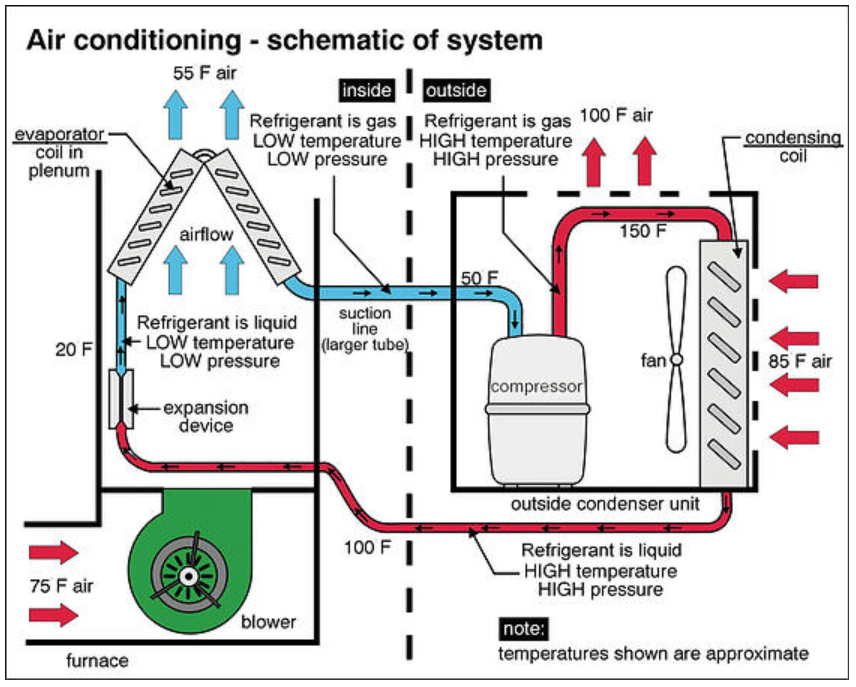The Benefits of Ductless Mini-Split Air Conditioning Systems
Designing With Convenience in Mind: Integrating Cooling in Design =================================================================
When it involves designing architectural spaces, the old stating 'type follows feature' applies. However have you ever considered exactly how integrating air conditioning into style can elevate comfort and efficiency all at once?

The smooth combination of cooling systems within the framework of a structure not only impacts the owners' well-being yet additionally influences the total sustainability of the structure. As you discover the complex connection in between style and a/c, a globe of innovative remedies and cutting-edge innovations awaits your discovery.
Secret Takeaways
- Energy-efficient systems boost convenience and sustainability.
- Integrated a/c boosts indoor air high quality.
- Stabilizing looks and performance makes certain perfect layout.
- Future fads focus on smart, lasting air conditioning services.
Relevance of Integrated Air Conditioning
When developing spaces, integrating a/c is crucial for making sure the very best convenience and functionality. Energy effectiveness plays a crucial duty in the style process, as it not just decreases functional expenses yet also lessens the environmental influence of the structure. By incorporating energy-efficient cooling systems, you can create a sustainable and affordable remedy that profits both the occupants and the planet.
In addition, interior air quality is another crucial element to consider when creating with integrated cooling. Proper air flow and filtering systems help maintain a healthy interior setting by reducing toxins and irritants. This brings about boosted resident health and wellness and performance. When choosing cooling systems, focus on those that use advanced purification technologies to enhance the overall interior air high quality.
Factors Influencing Style Choices
Integrating a/c right into architectural styles requires careful consideration of various variables that affect layout choices. When incorporating air conditioning systems, sustainability considerations are critical to reduce the building's environmental influence. https://harrowhvac.co.uk/air-conditioning-installation.html User experience plays a substantial duty in establishing the performance and complete satisfaction with the air conditioning system.
Power Efficiency: Lasting style techniques intend to minimize power usage, which not only profits the setting but also minimizes functional prices for the building proprietor.
Indoor Air Quality: Providing a comfy and healthy and balanced indoor environment improves the total individual experience, promoting productivity and health.
Appearances and Combination: Incorporating air conditioning systems flawlessly right into the building layout makes sure that performance does not jeopardize the visual appeal of the area, boosting customer fulfillment and general structure visual appeals.
Reliable Cooling Down Methods for Buildings
To optimize cooling down effectiveness in structures, take into consideration incorporating passive design techniques together with a/c systems. Passive cooling methods can substantially reduce the need for mechanical air conditioning, bring about even more lasting options for maintaining comfy indoor temperatures. Design attributes such as shielding devices, natural ventilation systems, and thermal mass can help manage temperature levels without relying entirely on energy-intensive cooling. By purposefully putting home windows to take full advantage of cross ventilation or utilizing reflective roof materials to decrease solar warmth gain, you can harness the power of nature to cool your building efficiently.
In addition to passive techniques, implementing sustainable solutions like green roofings or living walls can further enhance cooling performance by giving insulation and minimizing warmth absorption. These functions not only aid in keeping comfy indoor temperature levels yet additionally contribute to a greener atmosphere. By combining easy cooling techniques with sustainable services, you can develop a more energy-efficient and eco-friendly structure design that prioritizes both convenience and conservation.
Stabilizing Appearances and Performance
Take into consideration the unified combination of aesthetic components with useful facets in your building design to ensure a balanced and impactful end result. When including cooling systems right into your building layout, striking a balance in between looks and functionality is essential to developing rooms that not only look good yet likewise provide suitable comfort for residents.
To attain this equilibrium, keep the following points in mind:
 2. Blend the System with the Surroundings: Make certain that the a/c devices or vents perfectly integrate with the general visual of the room, whether via concealed positioning, attractive covers, or matching shades.
2. Blend the System with the Surroundings: Make certain that the a/c devices or vents perfectly integrate with the general visual of the room, whether via concealed positioning, attractive covers, or matching shades.
Prioritize Customer Experience: Design the air flow and temperature level control systems in a manner that focuses on the convenience and wellness of the residents. Consider variables such as air circulation, noise levels, and convenience of use to enhance the general user experience.
Include Sustainable Practices: Go with energy-efficient air conditioning services that not just contribute to the aesthetic allure of the structure but also advertise sustainability and decrease ecological impact.
Future Trends in Architectural Cooling
As you envision the future of building design, staying abreast of emerging cooling fads comes to be crucial for enhancing both type and function within your projects.
The integration of clever modern technologies right into architectural air conditioning systems is set to revolutionize the means structures are cooled down. These systems make use of information and automation to maximize power usage, providing customized comfort while minimizing ecological influence.
Sustainable services are also forming the future of building cooling. From easy design strategies that maximize natural air flow to innovative cooling materials that lessen the need for conventional cooling, sustainability goes to the center of cooling down developments. Engineers are progressively incorporating eco-friendly roofing systems, shielding aspects, and thermal mass right into their styles to develop even more energy-efficient air conditioning systems.
Regularly Asked Inquiries
Exactly How Does Air Conditioning Effect the Overall Sustainability and Power Performance of a Building Layout?
When you incorporate cooling right into building design, it affects sustainability and energy effectiveness. Energy usage can rise due to a/c usage, influencing building performance. This enhanced energy need can have adverse environmental effects, reducing overall sustainability.
To mitigate these results, think about incorporating energy-efficient a/c systems, correct insulation, and passive cooling techniques. Balancing convenience with energy effectiveness is very important for creating sustainable architectural layouts.
Exist Any Type Of Rules or Certifications That Architects Required to Consider When Integrating Air Conditioning Into Their Designs?
When incorporating a/c right into your layouts, it's vital to take into consideration governing demands like building codes and certification criteria for energy effectiveness. Satisfying these guidelines warranties that your project lines up with sector ideal methods and ecological goals.
Acquainting on your own with these regulations will assist you in developing lasting designs that prioritize comfort while additionally reducing energy usage. Keep informed and certified to provide jobs that are both comfy and eco-friendly.
Can the Positioning of Cooling Units Affect the Total Convenience and Performance of a Space?
When it involves air conditioning systems, placement matters a whole lot for your area's comfort and performance. https://harrowhvac.co.uk/air-conditioning-repair.html Air flow is essential, so avoid obstructing vents or putting devices in tight corners.
Take into consideration how sound pollution can affect your setting and go for a cosmetically pleasing setup that mixes seamlessly with your spatial layout.
Pay attention to where you position these systems to guarantee optimum convenience and efficiency throughout your room.
What Are Some Ingenious Technologies or Materials That Can Be Used to Enhance Cooling Systems in Modern Style?
To boost air conditioning systems in modern architecture, you can explore wise controls and sustainable products. Passive cooling techniques and utilizing thermal mass are innovative methods to enhance efficiency and convenience.
Exactly How Can Architects Ensure That the Design of Cooling Systems Matches the General Aesthetic of a Structure While Still Focusing On Capability and Convenience?
To assure the style of a/c systems matches a structure's visual, focus on visual integration and style consistency. Integrate energy-efficient modern technologies for performance. Balancing aesthetic appeals and performance enhances occupant comfort.

Highlight seamless integration of a/c elements into the building style. By focusing on both looks and power efficiency, designers can produce an area that's visually attractive, comfortable, and environmentally friendly.
Verdict
Overall, when developing with convenience in mind, incorporating a/c in architecture is essential. By taking into consideration factors such as effective cooling strategies, stabilizing visual appeals and performance, and staying in advance of future fads, engineers can produce spaces that aren't only aesthetically enticing yet likewise comfortable for passengers.
It is essential to prioritize the health and comfort of those who'll be making use of the room, and integrated cooling plays a vital role in accomplishing this goal.